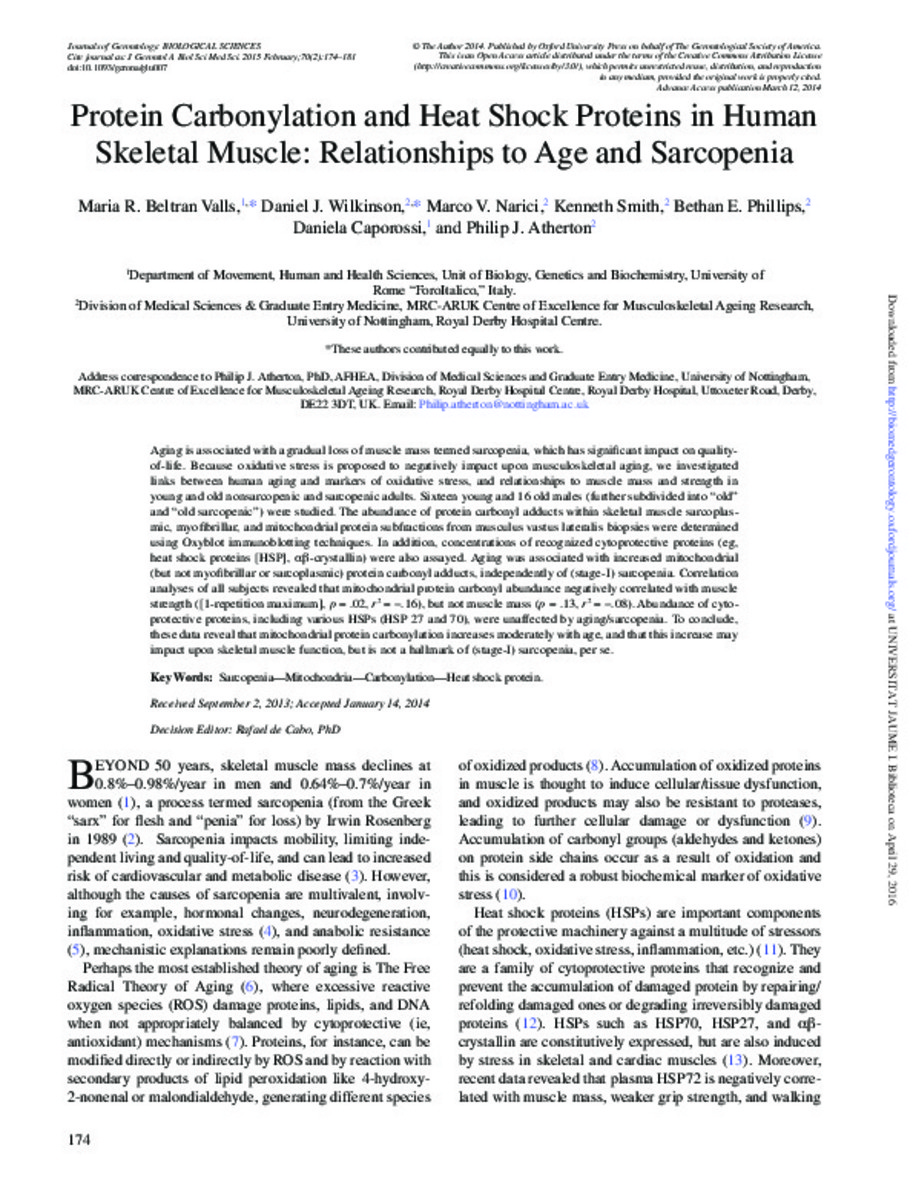Mostrar el registro sencillo del ítem
Protein Carbonylation and Heat Shock Proteins in Human Skeletal Muscle: Relationships to Age and Sarcopenia
| dc.contributor.author | Beltran Valls, Maria Reyes | |
| dc.contributor.author | Wilkinson, Daniel J. | |
| dc.contributor.author | Narici, Marco Vincenzo | |
| dc.contributor.author | Smith, Kenneth | |
| dc.contributor.author | Phillips, Bethan E. | |
| dc.contributor.author | Daniela, Caporossi | |
| dc.contributor.author | Atherton, Philip J. | |
| dc.date.accessioned | 2016-04-29T11:57:28Z | |
| dc.date.available | 2016-04-29T11:57:28Z | |
| dc.date.issued | 2015 | |
| dc.identifier.citation | BELTRÁN VALLS, Maria R., et al. Protein carbonylation and heat shock proteins in human skeletal muscle: relationships to age and sarcopenia. The Journals of Gerontology Series A: Biological Sciences and Medical Sciences, 2015, vol. 70, no 2, p. 174–181 | ca_CA |
| dc.identifier.issn | 1079-5006 | |
| dc.identifier.issn | 1758-535X | |
| dc.identifier.uri | http://hdl.handle.net/10234/159048 | |
| dc.description.abstract | Aging is associated with a gradual loss of muscle mass termed sarcopenia, which has significant impact on quality-of-life. Because oxidative stress is proposed to negatively impact upon musculoskeletal aging, we investigated links between human aging and markers of oxidative stress, and relationships to muscle mass and strength in young and old nonsarcopenic and sarcopenic adults. Sixteen young and 16 old males (further subdivided into “old” and “old sarcopenic”) were studied. The abundance of protein carbonyl adducts within skeletal muscle sarcoplasmic, myofibrillar, and mitochondrial protein subfractions from musculus vastus lateralis biopsies were determined using Oxyblot immunoblotting techniques. In addition, concentrations of recognized cytoprotective proteins (eg, heat shock proteins [HSP], αβ-crystallin) were also assayed. Aging was associated with increased mitochondrial (but not myofibrillar or sarcoplasmic) protein carbonyl adducts, independently of (stage-I) sarcopenia. Correlation analyses of all subjects revealed that mitochondrial protein carbonyl abundance negatively correlated with muscle strength ([1-repetition maximum], p = .02, r 2 = −.16), but not muscle mass (p = .13, r 2 = −.08). Abundance of cytoprotective proteins, including various HSPs (HSP 27 and 70), were unaffected by aging/sarcopenia. To conclude, these data reveal that mitochondrial protein carbonylation increases moderately with age, and that this increase may impact upon skeletal muscle function, but is not a hallmark of (stage-I) sarcopenia, per se. | ca_CA |
| dc.description.sponsorShip | The samples used within this study were from a grant supported by the Biotechnology and Biological Sciences Research Council (BB/X510697/1338 and BB/C516779/1). | ca_CA |
| dc.format.extent | 8 p. | ca_CA |
| dc.format.mimetype | application/pdf | ca_CA |
| dc.language.iso | eng | ca_CA |
| dc.publisher | The Gerontological Society of America | ca_CA |
| dc.publisher | Oxford University Press | ca_CA |
| dc.relation.isPartOf | The Journals of Gerontology Series A: Biological Sciences and Medical Sciences, 2015, vol. 70, no 2 | ca_CA |
| dc.rights | © The Gerontological Society of America | ca_CA |
| dc.rights | Attribution 4.0 | * |
| dc.rights.uri | http://creativecommons.org/licenses/by-sa/4.0/ | * |
| dc.subject | sarcopenia | ca_CA |
| dc.subject | mitochondria | ca_CA |
| dc.subject | carbonylation | ca_CA |
| dc.subject | heat shock protein | ca_CA |
| dc.title | Protein Carbonylation and Heat Shock Proteins in Human Skeletal Muscle: Relationships to Age and Sarcopenia | ca_CA |
| dc.type | info:eu-repo/semantics/article | ca_CA |
| dc.identifier.doi | http://dx.doi.org/10.1093/gerona/glu007 | |
| dc.rights.accessRights | info:eu-repo/semantics/openAccess | ca_CA |
| dc.relation.publisherVersion | http://biomedgerontology.oxfordjournals.org/content/70/2/174.full | ca_CA |
Ficheros en el ítem
Este ítem aparece en la(s) siguiente(s) colección(ones)
-
EDU_Articles [501]








